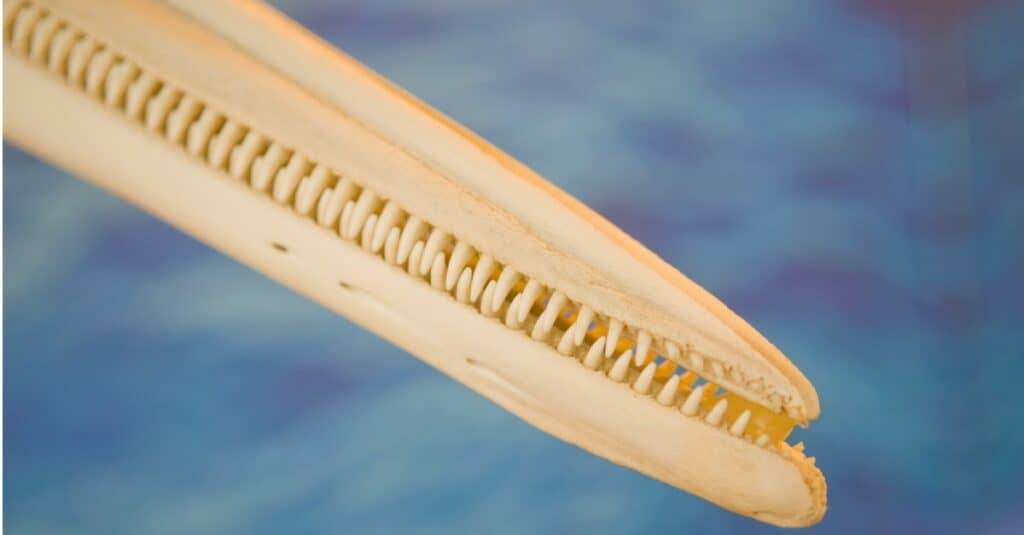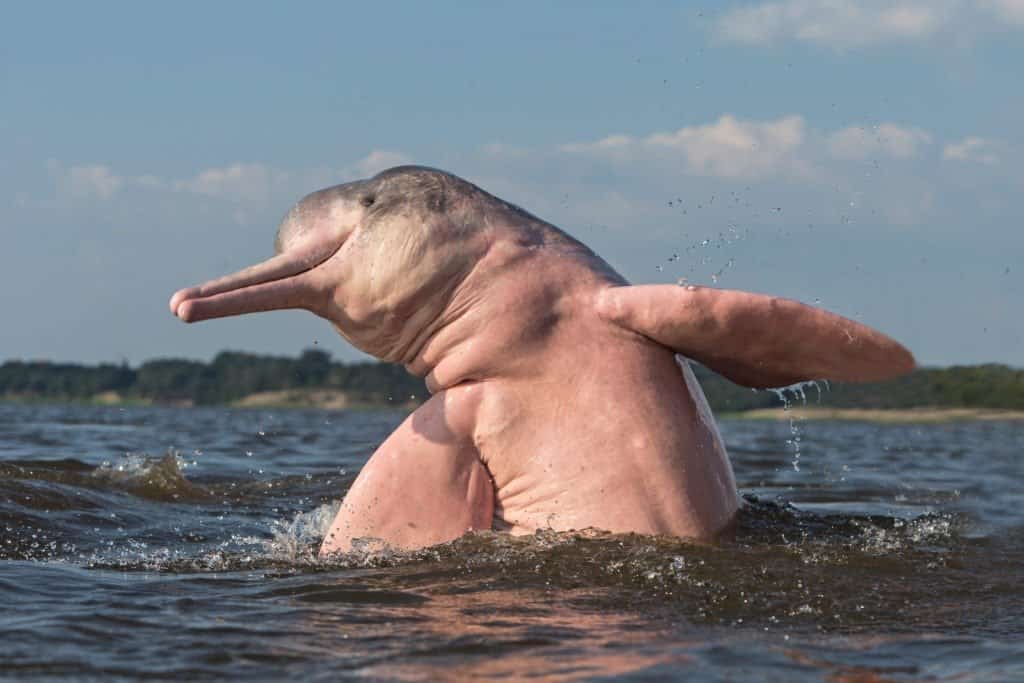Dolphins live in all the world’s oceans, and even some of the largest freshwater rivers. Like whales, they’re considered cetaceans–marine dwelling mammals. There are four main families of dolphin, with 40 extant (living) species. Of these 40 species, 30 of them are within the Delphinidae family of oceanic dolphins. The other three families (Iniidae, Pontoporiidae, and Platanistidae) comprise the world’s river dwelling dolphins. Dolphins are mammals, eat meat, and have teeth.
Here, we’ll learn all about dolphin dentition. Each species of dolphin is unique, but they all follow the same general rules when it comes to dentition. We’ll explore just how many teeth are normal for a dolphin, and what it is that makes dolphin teeth special. Then, we’ll go in depth on a couple of unique species with specialized mouths (for dolphins), and discuss how scientists determine dolphin’s ages from their teeth.
How Many Teeth Do Dolphins Have?

Dolphins have an incredible amount of teeth that line their jaws. Some dolphins have up to 268 teeth!
©iStock.com/evanming
Dolphins evolved from land dwelling creatures millions of years ago. As they adapted to life in the ocean, they also grew to have many more teeth than their terrestrial ancestors. Because dolphins have more than 44 teeth per mouth quadrant (think upper, lower, left, and right), they are known as polyodonts. Polyodonty means ‘many teeth’, and dolphins certainly live up to the name.
Let’s take a look at the teeth of a few of the most common species of dolphin.
- Short-beaked common dolphin (Delphinus delphis): 160-228
- Long-beaked common dolphin (Delphinus capensis): 188-268
- Bottlenose dolphin (Tursiops truncatus): 72-116
- Spinner dolphin (Stenella longirostris): 180-260
- Pacific white-sided dolphin (Lagenorhynchus obliquidens): 92-144
What Type of Teeth Do Dolphins Have?

Dolphins have up to 265 teeth
©Andrea Izzotti/Shutterstock.com
Dolphins are odontocetes, meaning toothed cetacean. They share this characteristic with other cetaceans like sperm whales, beaked whales, and porpoises. The largest member of the dolphin family is the orca whale (Orcinus orca). It may be large, but even the orca (also called killer whale) shares the same dentition as the much smaller bottlenose dolphin.
Almost all dolphin species are homodonts, meaning they only have one type of tooth. In comparison; humans have four distinct types of tooth–incisors, canines, premolars, and molars. The dolphin’s sole tooth type is small (up to ½ inch in length) and conical. Depending on the species of dolphin, these teeth may be blunt or sharp–it all depends on what they like to eat.
Diet and Teeth
Dolphins mostly eat fish, krill, plankton, and cephalopods (squid). But different species of dolphin may eat more of one than the other; this is where differences in teeth appear. Some species, like the bottlenose dolphin, eat a general diet of fish, squid, and krill, and have very typical, conical, blunt teeth. While other species, like the orca whale, eat mostly large prey like seals, and have sharper teeth for tearing flesh. Still other species of dolphin have even more specialized dentition for their unique diets–more on that later.
Social Hierarchy
Dolphins don’t just use their pearly whites to catch fish; they also use them to establish dominance among other dolphins. Dolphins are social creatures, and live in pods of up to dozens of animals. Each pod has a unique social hierarchy, starting with the lowest ranked (often the youngest) individuals, and moving up to the most dominant members of the group.
One of the tools dolphins use to establish their dominance is a behavior called ‘raking’. Raking happens when a dolphin scrapes its anterior (front) teeth against the body or face of another member of the pod. This leaves a series of shallow cuts in the other dolphin’s skin. They’re not life threatening, but the teeth seem to send the message: stay in line, and respect the hierarchy.
Do All Dolphins Have Teeth?

Amazon river dolphins are one of the few species of dolphin with molar-like teeth
©COULANGES/Shutterstock.com
All dolphins have teeth. Most of them have many teeth (upwards of 150), but one species (Risso’s dolphin) has fewer than 20 teeth in its entire mouth. Additionally, both the Risso’s dolphin and the Amazon river dolphin have teeth that are a little more complex than the average cetacean.
Risso’s Dolphin
Risso’s dolphins (Grampus griseus) live in temperate and tropical oceans around the world. They have perhaps the most specialized dentition of all in that they have no upper teeth, and only 4-14 teeth in their lower jaw. What teeth they do have are located at the very front of the mouth, and are much sharper than the typical dolphin. Risso’s dolphins have this specialized dentition because they eat almost entirely squid.
Amazon River Dolphin
Amazon river dolphins (Inia geoffrensis) live in the freshwaters of the Amazon and Orinoco river basins. They are famously pink colored, and have a varied diet of fish, turtles, and crabs. Because they eat harder foods like crab and turtle, they have developed flatter, molar-like, teeth towards the backs of their mouths. These dolphins are technically considered heterodonts–meaning they have more than one type of tooth.
Telling a Dolphin’s Age From Its Teeth
Dolphin calves spend the first few months of life living off of their mother’s milk. Once they’re around three months old, their teeth start to erupt. By the time they’re six months old, they have all of their adult teeth. Dolphins are monophyodonts, which means they only have one set of pearly whites for life.
As dolphins age, their teeth grow in layers, like a tree. For every year of life, the dolphin gains a layer of dental material. In the case of necropsies (medical examinations of deceased dolphins) scientists can use these layers to determine the dolphin’s precise age.
Dolphins also exhibit dental wear as they age. This is particularly evident in the anterior teeth, which undergo the most use. As teeth wear, they become blunter and more rounded off, and may eventually become even stubby in appearance. Dolphins don’t regrow teeth; once their teeth wear out, they don’t come back.
The photo featured at the top of this post is © Irina No/Shutterstock.com
Thank you for reading! Have some feedback for us? Contact the AZ Animals editorial team.







